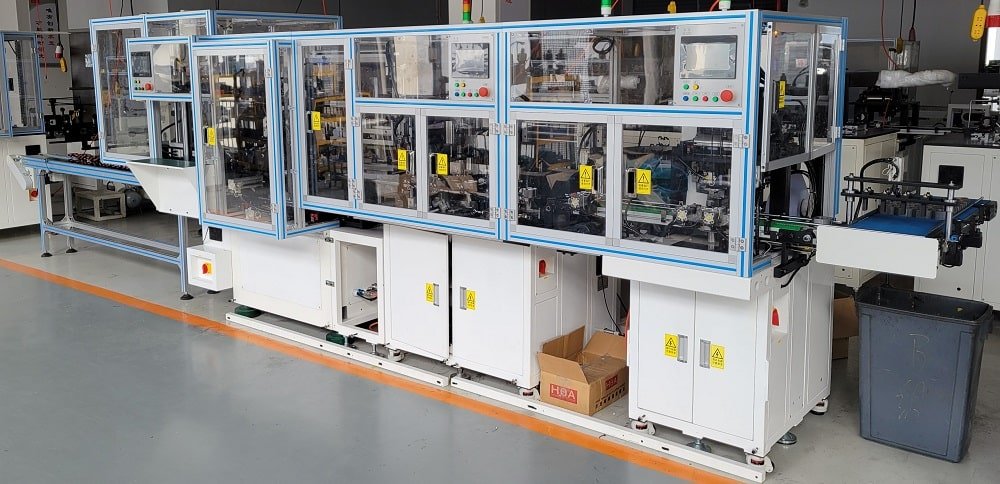The maintenance of rotor automatic assembly line is an important measure to ensure its stable operation and prolong its service life. The following will be from the daily cleaning and inspection, lubrication management, electrical and gas source inspection, equipment calibration and adjustment, preventive maintenance and fault management, as well as personnel training and safety management, etc., a detailed introduction to the rotor automatic assembly line maintenance work. Vacuz briefly to introduce to you.

Šepečio variklio statoriaus ritės gamybos linija
I. Daily cleaning and inspection
Daily cleaning and inspection is the basic work of maintenance. First of all, we should keep the production line and the table clean and tidy, and pay attention to check the various workstations and debris before going to and from work, and do a good job of categorization to ensure that the production line does not leave products or foreign objects. Secondly, regularly remove the dust and dirt on the motor shell and heat sink to maintain good heat dissipation performance. For other equipment on the production line, should also be regularly cleaned to prevent the accumulation of dust and dirt leading to equipment failure.
Second, lubrication management
Lubrication management is to ensure the normal operation of the equipment is a key link. To do a good job of the various bearings and connecting parts (such as screws, rails, couplings, etc.) of the lubrication work, regular maintenance, to ensure normal operation. At the same time, according to the manufacturer’s recommended lubrication cycle and lubricant type lubrication, to avoid the use of inappropriate lubricants lead to equipment damage.
Third, electrical and gas source inspection
Electrical and gas source inspection is to ensure the safe and stable operation of the equipment is an important step. To check whether the electrical line is normal, pay attention to maintenance, prevent aging, to ensure that the lines are firmly connected, no short-circuit or broken phenomenon. At the same time, to ensure that the gas source to meet the needs of the normal operation of the cylinder, regularly check the pressure and stability of the gas source to ensure the normal operation of the equipment.
Fourth, equipment calibration and adjustment
Equipment calibration and adjustment is an important means to improve the accuracy and stability of equipment. We should pay attention to check whether the fixture and sensor parts of each station are offset, if there is offset to be corrected in a timely manner to ensure the accuracy and stability of the equipment. In addition, it is also necessary to check the wear and tear of the belt, chain, gears and other transmission components, and timely replacement of severely worn parts to maintain transmission efficiency.
Fifth, preventive maintenance and fault management
Preventive maintenance and fault management is to reduce the failure rate of equipment and extend the service life of effective measures. According to the type of production line equipment, frequency of use and working environment, to develop a detailed monthly, quarterly and annual maintenance program, clear maintenance projects, cycles and responsible person. At the same time, the implementation of regular inspections, including motor appearance inspection, running sound listening, vibration monitoring, etc., timely detection and treatment of potential problems. In addition, it is also necessary to establish a failure file, a detailed record of each failure time, phenomenon, treatment process and results, regular statistical analysis of failure data, identify the failure frequency points, take targeted preventive measures to reduce the failure rate.
Sixth, personnel training and safety management
Personnel training and safety management is to ensure that equipment maintenance and repair work is carried out smoothly an important guarantee. Regular production line operators and maintenance personnel to carry out equipment maintenance knowledge and skills training to enhance their professional skills and emergency response capabilities. At the same time, we should strengthen safety education to ensure that operators comply with safety regulations to prevent accidents.

BLDC Motor Stator Coil Production Line
To summarize, the maintenance of automatic rotor assembly line involves many aspects, including daily cleaning and inspection, lubrication management, electrical and gas source inspection, equipment calibration and adjustment, preventive maintenance and fault management, as well as personnel training and safety management. Through scientific maintenance measures and strict management system, it can ensure the stable operation and prolong the service life of the production line, and create greater economic benefits for the enterprise.
El. paštas: sales@vacuz.com





